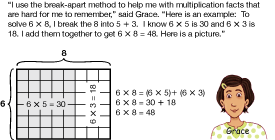Students extend the break-apart method to one-digit by 2-digit multiplication problems. For example, 6 × 32 is broken into 6 × 30 + 6 × 2. To model this idea, they draw a rectangular array on grid paper to represent a product, divide the array into two smaller arrays that represent easier products, and add the easier products to get their answers. They then make connections between using rectangles and using expanded form to multiply.
Content in this Lesson
- Representing and solving multiplication problems using rectangular arrays [E1, MPE5].
- Breaking products into the sum of simpler products to solve one-digit by two-digit multiplication problems (applying the distributive property) [E9].
- Communicating reasoning [MPE5].
Daily Practice and Problems EE–HH
Assessment in this Lesson
| Assessment | Expectation Assessed | Math Practices Expectation Assessed |
|---|---|---|
|
Break-Apart Products with Larger Numbers Check-In: Questions 9–10 Student Guide Page 105 |
|
|
|
DPP Item EE Quiz on 5s and 10s Teacher Guide - digital Page 36 |
|
|
|
Unit 3 Test with Feedback Box Teacher Guide - digital |
|
|



















